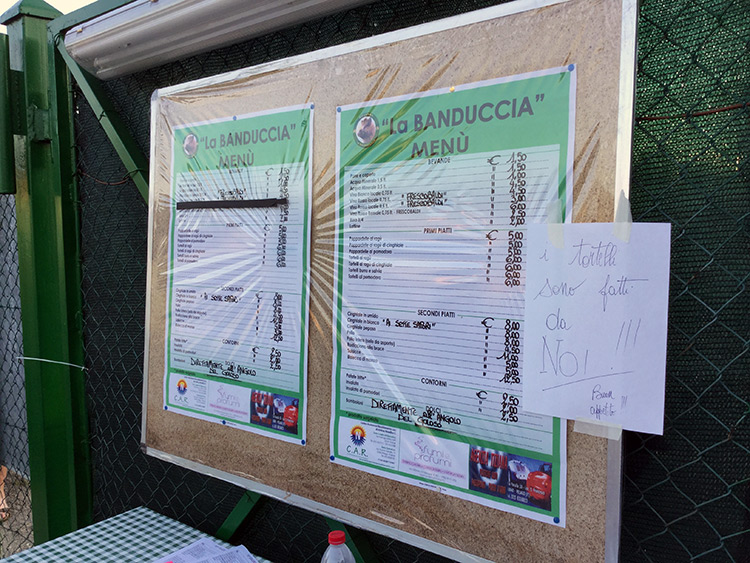What to eat
Since a sagra is an event dedicated to a special food, a recipe, or some few recipes of traditional cuisine, the menu is focused on that matter. That's why quite everywhere the menu of a sagra has nothing to compare to the vastness of a restaurant's menu.
Moreover, food is prepared by a staff of volunteers, which are local and usually live in the village where the sagra is held. These volunteers are usually elder inhabitants, often a mix of old women and men who know very well the recipes and the local traditional cuisine, so it's absolutely normal that they have the task to cook.
People attending a sagra go there to eat precisely the delicious specialties that these elders are supposed to cook incomparably well, as the elders know how to prepare them, since ever. For this reason, no one cares about the shortness of the menu. This means you will not find a long list of Italian, or Tuscan specialties on the menu itself, unlike a normal Tuscan or Italian restaurant. Consequently, you will not need to decide on a vast choice of dishes. That's why in a sagra it would have no sense to sit at a table, take the menu, and have all your time to choose from the many pages of this menu what to eat and, after decided, call a waiter. In a sagra, you choose the dishes, you pay at the cash receiving a receipt. Then you sit at a table, waiting for someone to take your receipt, and finally the dishes are brought to the table.

So the first thing to do when you arrive at a sagra is to look for the menu and choose what you’d like to eat. In many cases, you will find a big menu, written on a paper or a big cardboard, somewhere near the cash. Usually, there will be some people reading it, just to choose as you the dishes. In other cases, you will find the menu written on some small papers all around, on some tables near the cash for instance. In both cases, it's a good idea to check very well the menu, also because it's quite always in Italian, without a translation in English. Generally people know the dishes or at least they have an idea about. You may encounter more problems to understand, but usually dishes are divided in the same way or a big Italian meal: antipasti (appetizers), primi piatti (first courses), secondi piatti (second courses), contorni (garnishes), dessert or dolce (cakes).
Clearly the best idea is to take at least one of the main dishes, or a dish with the ingredient the sagra is dedicated to. Just to do some example, at Sagra del Fungo, try the porcini mushrooms; at a Sagra dell'Ocio, try the ocio, that is the goose; at a Sagra dell'Acquacotta, try the acquacotta that is a soup.
While rarely the main dishes prepared in a traditional sagra are disappointing, this doesn't mean that the other part of the menu is less delicious! So if you are at the sagra del Fungo Porcino in Pievescola, while it's a pity to miss the wonderful porcini mushrooms, the other things you have in the menu are no less wonderful, like the grilled meat or some of the first courses like pasta with…


